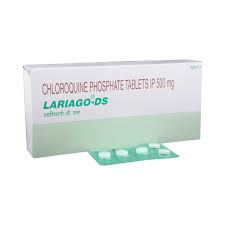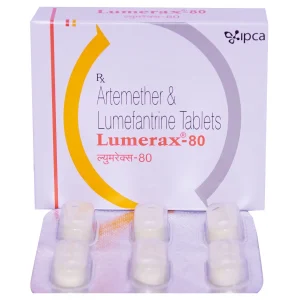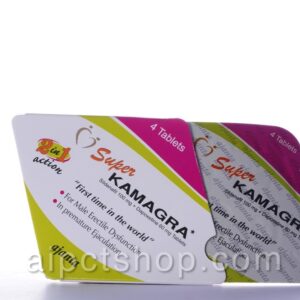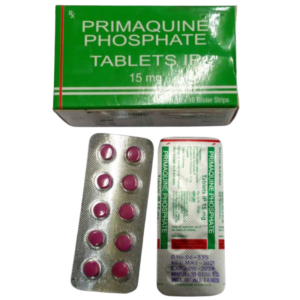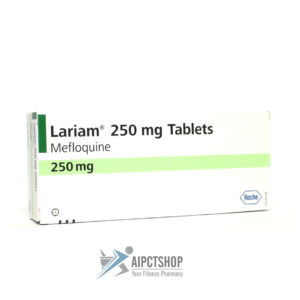Lariago-DS Information
Lariago-DS™ is an anti-Malaria medication used in the treatment as well as prevention of Malaria. It works by stopping the growth of parasites in the red blood cells of the human body. Lariago-DS™ is also used off-label for the treatment of Coronavirus (COVID-19).
Pronunciation
(KLOR oh kwin)
What is this drug used for?
• It is used to treat or prevent malaria.
• It is used to treat a type of bowel infection.
• It may be given to you for other reasons. Talk with the doctor.
Frequently reported side effects of this drug
• Abdominal pain
• Abdominal cramps
• Lack of appetite
• Nausea
• Vomiting
• Headache
• Diarrhea
• Skin discoloration
• Hair discoloration
• Hair loss
Other side effects of this drug: Talk with your doctor right away if you have any of these signs of:
• Liver problems like dark urine, fatigue, lack of appetite, nausea, abdominal pain, light-colored stools, vomiting, or yellow skin
• Low blood sugar like dizziness, headache, fatigue, feeling weak, shaking, fast heartbeat, confusion, increased hunger, or sweating
• Blurred vision
• Vision changes
• Vision loss
• Eye pain
• Severe eye irritation
• Abnormal movements
• Agitation
• Seizures
• Trouble sleeping
• Confusion
• Behavioral changes
• Mood changes
• Sensing things that seem real but are not
• Trouble hearing
• Noise or ringing in the ears
• Muscle pain
• Muscle weakness
• Burning or numbness feeling
• Chills
• Sore throat
• Bruising
• Bleeding
• Heart problems like cough or shortness of breath that is new or worse, swelling of the ankles or legs, abnormal heartbeat, weight gain of more than five pounds in 24 hours, dizziness, or passing out
• Severe loss of strength and energy
• Stevens-Johnson syndrome/toxic epidermal necrolysis like red, swollen, blistered, or peeling skin (with or without fever); red or irritated eyes; or sores in mouth, throat, nose, or eyes
• Signs of a significant reaction like wheezing; chest tightness; fever; itching; bad cough; blue skin color; seizures; or swelling of face, lips, tongue, or throat.
Medication Safety Issues
International issues:
Aralen [U.S., Mexico] may be confused with Paralen brand name for acetaminophen [Czech Republic]
Storage/Stability
Store at 25°C (77°F); excursions are permitted between 15°C and 30°C (59°F and 86°F); protect from light.
Adverse Reactions
Frequency not defined.
Cardiovascular: Atrioventricular block, bundle branch block, cardiac arrhythmia, cardiomyopathy, ECG changes (including prolonged QRS and QTc intervals, T-wave inversion, or depression), hypotension, torsades de pointes, ventricular fibrillation, ventricular tachycardia
Central nervous system: Agitation, anxiety, confusion, decreased deep tendon reflex, delirium, depression, extrapyramidal reaction (dystonia, dyskinesia, protrusion of the tongue, torticollis), hallucination, headache, insomnia, motor dysfunction (sensorimotor disorder), personality changes, polyneuropathy, psychosis, seizure, suicidal tendencies
Dermatologic: Alopecia, bleaching of hair, blue gray skin pigmentation, erythema multiforme, exacerbation of psoriasis, exfoliative dermatitis, lichen planus, pleomorphic rash, pruritus, skin photosensitivity, Stevens-Johnson syndrome, toxic epidermal necrolysis, urticaria
Endocrine & metabolic: Hypoglycemia
Gastrointestinal: Abdominal cramps, anorexia, diarrhea, nausea, vomiting
Hematologic & oncologic: Agranulocytosis (reversible), aplastic anemia, hemolytic anemia (in G6PD-deficient patients), neutropenia, pancytopenia, thrombocytopenia
Hepatic: Hepatitis, increased liver enzymes
Hypersensitivity: Anaphylactoid reaction, anaphylaxis, angioedema
Immunologic: DRESS syndrome
Neuromuscular & skeletal: Myopathy, neuromuscular disease, proximal myopathy
Ophthalmic: Accommodation disturbances, blurred vision, corneal opacity (reversible), macular degeneration (may be irreversible), maculopathy (may be irreversible), nocturnal amblyopia, retinopathy (including irreversible changes in some patients’ long-term or high-dose therapy), transient scotomata, visual field defects
Otic: Deafness (nerve), hearing loss (risk increased in patients with preexisting auditory damage), tinnitus

